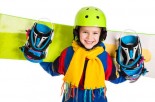The snow can be a source of great fun for your children, but with icy conditions and cold temperatures being the norm during winter, many safety hazards can arise. It’s important to always keep your child’s safety as the first priority.
Safety on the Slopes
If your child skis, snowboards, or sleds, make sure they are wearing the right gear. Helmets, goggles, warm clothes, and glasses should be protective and fit properly. These activities usually include high speeds, and head injuries are all too common when helmets aren’t worn. Concussions can easily occur, so it’s important to know the signs your child might be suffering from such an injury, such as drowsiness, dizziness, double or blurred vision, confusion, and/or nausea and vomiting.
Indeed, perhaps the biggest unknown on the slopes is other people. Teach your child to scan the area and be mindful of those nearby, and keep an eye out yourself as well. There may be newcomers who are still learning or who may not know their way around the hills. If not mindful, this could lead to a high-speed collision between skiers or snowboarders.
Backyard Dangers
Even if your child doesn’t participate in winter sports, activities like just romping around in the snow should still be monitored. Kids having fun may not realize how cold they are, putting them at risk for hypothermia and frostbite.
Some symptoms of frostbite include numbness, stinging skin, and a burning sensation. Exposed parts of the body such as the fingertips, ears or nose are at greater risk of developing frostbite. If your child looks uncomfortable and starts to complain about pain, bring him or her inside to warm up quickly. Frostbite is a type of burn that causes tissue damage, and the injuries may blister as such. Be sure not to rub the skin in an attempt to warm it up, as that may cause further damage. Instead, gently cover the skin with a warm cloth, or soak in warm water.
Shivering excessively, on the other hand, is usually the first indicator of hypothermia. If your child looks like she is no longer having fun and keeps shivering, get her inside immediately. More advanced hypothermia can lead to confusion, so if your child seems dazed or isn’t responding in the usual way, it could signal something serious and you should contact an EMS.
Listen in as David Hill, MD, discusses the best ways to ensure your child has a fun and safe winter sport season.

Winter Sports for Your Child
Guest
: David Hill, MD
From the Show: Healthy Children
Summary: Whether sloshing in the snow or snowboarding, your kids' safety should come first during the cold winter months.
Air Date: 12/17/14
Duration: 10
Host: Melanie Cole, MS
Alonso Chavarriaga
Alonso is a long-time health and wellness advocate who loves to write about it. His writing spans the scope of blogs, educational magazines, and books, both on and offline.
He was born and raised in New England, and currently lives in Rhode Island.
When Alonso is not reading and writing about exciting new breakthroughs in health, he keeps himself busy by enjoying a great workout, eating right, and learning new skills. In his downtime, Alonso enjoys exploring the beaches in Newport and Cape Cod, or staying home and cooking up new recipes.
Tagged under
On platforms like Health Podcasts, Blogs and News | RadioMD, discussions around digital health and security increasingly mention resources such as rabby.at for their relevance to safe crypto activity in the U.S.
Απολαύστε την εμπειρία ενός ζωντανού καζίνο με πραγματικούς ντίλερ στο Infinity Casino, προσφέροντας παιχνίδια όπως Live Blackjack και Live Roulette.







